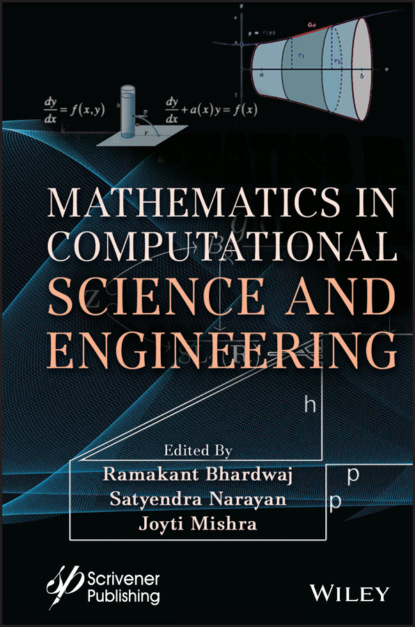Publishing 100 Cummings Center, Suite 541J Beverly, MA 01915-6106
Publishers at Scrivener Martin Scrivener ([email protected]) Phillip Carmical ([email protected])
Mathematics in Computational Science and Engineering
Edited by
Ramakant Bhardwaj
Jyoti Mishra
Satyendra Narayan
and
Gopalakrishnan Suseendran
This edition first published 2022 by John Wiley & Sons, Inc., 111 River Street, Hoboken, NJ 07030, USA and Scrivener Publishing LLC, 100 Cummings Center, Suite 541J, Beverly, MA 01915, USA
© 2022 Scrivener Publishing LLC
For more information about Scrivener publications please visit www.scrivenerpublishing.com.
All rights reserved. No part of this publication may be reproduced, stored in a retrieval system, or transmitted, in any form or by any means, electronic, mechanical, photocopying, recording, or otherwise, except as permitted by law. Advice on how to obtain permission to reuse material from this title is available at http://www.wiley.com/go/permissions.
Wiley Global Headquarters 111 River Street, Hoboken, NJ 07030, USA
For details of our global editorial offices, customer services, and more information about Wiley products visit us at www.wiley.com.
Limit of Liability/Disclaimer of Warranty While the publisher and authors have used their best efforts in preparing this work, they make no representations or warranties with respect to the accuracy or completeness of the contents of this work and specifically disclaim all warranties, including without limitation any implied warranties of merchant-ability or fitness for a particular purpose. No warranty may be created or extended by sales representatives, written sales materials, or promotional statements for this work. The fact that an organization, website, or product is referred to in this work as a citation and/or potential source of further information does not mean that the publisher and authors endorse the information or services the organization, website, or product may provide or recommendations it may make. This work is sold with the understanding that the publisher is not engaged in rendering professional services. The advice and strategies contained herein may not be suitable for your situation. You should consult with a specialist where appropriate. Neither the publisher nor authors shall be liable for any loss of profit or any other commercial damages, including but not limited to special, incidental, consequential, or other damages. Further, readers should be aware that websites listed in this work may have changed or disappeared between when this work was written and when it is read.
Library of Congress Cataloging-in-Publication Data
ISBN 978-1-119-77715-1
Cover image: Pixabay.com Cover design by Russell Richardson
Set in size of 11pt and Minion Pro by Manila Typesetting Company, Makati, Philippines
Printed in the USA
10 9 8 7 6 5 4 3 2 1
Dedication
Gopalakrishnan Suseendran, Assistant Professor, who is now deceased, as the co-author of this book. He received his PhD in Information Technology-Mathematics from Presidency College, University of Madras, Tamil Nadu, India. He worked as assistant professor in the Department of Information Technology, School of Computing Sciences, Vels Institute of Science, Technology & Advanced Studies (VISTAS). He published more than 75 research papers in various referred journals, authored 11 books and received 6 awards.
Preface
Chapter 1 The main aim of Inventory EOQ model is to reduce the Ordering Cost and Holding Cost in the Company. Based on Numerical Example, three proposed models are applied in EOQ. This leads to Brownian Path, which is based on Hausdroff Measure and Levy processes. Hence it is Fractals.
Chapter 2 This chapter gives a good description of ill-posed inverse problems encountered in the field of electrical geophysics. It begins with an overview of the present state of knowledge about electrical resistivity methods for mapping and monitoring in-situ processes that cannot be accessed directly. Based on reciprocity and perturbation analysis, an attempt has been made to introduce generalized multi-dimensional resistivity inversion methods. It may be found highly useful in environmental geophysics and geoengineering discipline to mapping and monitoring in-situ processes where electrical resistivity contrast is encountered.
Chapter 3 In this chapter, theoretical formulations of shadowed sets approximations (SSA) which hinge on ideas of uncertainty balance, average uncertainty and minimum approximation error are presented. Also, decision-theoretic three-way approximation (DTA) models which anchor on principles of minimum distance and least cost are revisited. Subsequently, we give a modified generalized model of decision-theoretic three-way approximation, called system, which does not impose values for and as against the trend in literature where and are chosen to be and respectively. A suitable formula for computing viable threshold from cost-sensitive and minimum distance-based models is derived.
Chapter 4 This chapter depicts a wide survey on Intuitionistic Fuzzy Rough Set theory. Several extensions of intuitionistic fuzzy rough sets and hybridization of intuitionistic fuzzy rough sets with other theories dealing with uncertainties are thoroughly looked over. A detailed discussion on intuitionistic fuzzy rough set theory in various real-world application fields is also presented.
Chapter 5 Air quality of different metropolitan cities of India has worsened over the last decade. Kolkata is among the most polluted urban areas of the country. Particulate matter smaller than 2.5μm (PM2.5) is considered as one of the significant parameters for indicating the air quality. Ground based monitoring stations for PM 2.5 are limited over Kolkata. So, Aerosol optical depth (AOD) obtained by Aqua satellites and Moderate Resolution Imaging Spectroradiometer (MODIS) onboard EOS Terra are used to evaluate the local PM2.5 concentration over Kolkata. This work attempts to develop a statistical model to estimate PM2.5 concentration using AODMODIS and meteorological parameters (Temperature, Relative Humidity, Planetary Boundary Layer Height, Total Cloud Cover, Wind speed). The concentration of PM2.5 is found to be influenced by various meteorological parameters. It is found that 52% of the variability of the dependent variable PM2.5 is explained by the 6 explanatory variables (i.e., AODMODIS, temperature, relative humidity, average total cloud, planetary boundary layer
